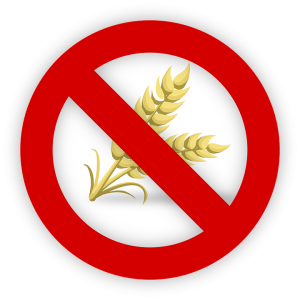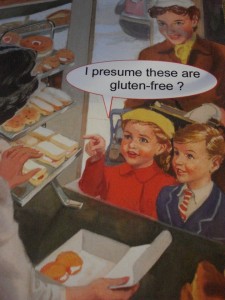
09 Apr No Nonsense Guide to Gluten free
You have to watch this one minute clip from Jimmy Kimmel as he surveys people about gluten. Their responses are hilarious. It’s amazing how people just jump on the latest band wagon whether they understand it or not!
Gluten is a protein found in wheat, barley, spelt and rye. The word gluten comes from the Latin word for glue. Gluten is literally the glue that holds breads and cakes together, and makes them fluffy after they cook. It often contaminates non-gluten products like oats made in the same factory, since it’s sticky and can circulate in the air in factories producing wheat products and stick to other non-gluten products.
Is gluten bad for everyone?
Gluten’s stickiness can impact our body, interfering with proper digestion and absorption of nutrients. Modern wheat has been genetically modified to grow faster and to produce a higher yield of wheat per acre. It also contains more gluten, which many experts believe has led to an increase in the number of people with Celiac Disease (gluten allergy), gluten intolerance and gluten sensitivity.
Gluten sensitivity can cause different symptoms such as gastrointestinal (constipation, diarrhea, nausea, bloating), neurological (aggravate dementia, ADHD, autism, schizophrenia, depression) and autoimmune disorders (psoriasis, Hashimoto’s thyroiditis, arthritis) as well as osteoporosis, anemia, infertility and fatigue. (1)
A new study, published in the British Journal of Nutrition, proved that modern wheat is not the same as that of our ancestors. The results showed after six weeks eating an ancient variety of wheat, rather than modern wheat, participants noticed significant improvements in IBS symptoms, such as abdominal pain and distention, bloating and quality of life. In addition, the inflammatory substances in their blood decreased. (2) This might be why Americans notice less digestive issues in Europe than at home.
Not only is gluten found in the grains mentioned above, it can be found in things like soy sauce, beer, soups, sauces and most baked goods. Check the food label to determine if gluten is contained in specific products. If you have a severe gluten allergy or celiac disease, you need to avoid gluten and only eat packaged products labeled certified gluten free or those foods that are naturally gluten free (see below).
Naturally Gluten Free Foods
The best way to avoid Gluten is to choose naturally Gluten Free Foods, such as fruits, vegetables, nuts, seeds, beans, fish, meats, poultry, dairy products and non-gluten whole grains. Some delicious non-gluten grains are Amaranth, Brown Rice*, Buckwheat, Cornmeal*, Millet, Quinoa, Wild Rice, Oatmeal* and Oats*. It’s important to note * may have gluten contamination, so check the label to confirm it contains the ‘Certified Gluten Free’ label.
Gluten Free products: not necessarily “better”
A healthful diet consists of the foods listed above which are naturally gluten free. If you choose to eat ‘Gluten Free’ processed foods, there are a few important things to keep in mind:
- Gluten free (GF) does not necessarily mean healthy.
- GF processed foods are still processed foods. Many can be even worse for you than “regular” processed foods because they are more refined and may have minimal nutritional value.
- GF products often are not enriched (where vitamins are added back into the food after they’re stripped out).
- GF processed food won’t help you lose weight.
- GF products often contain sugar as the first ingredient. Read the labels to ensure you are buying something that’s good for your body. The fewer the ingredients, the less added sugar, and no hydrogenated oils, the better for you.
If you have a gluten allergy or suspect one, it’s important to go 100% GF because our bodies are smart – they remember gluten is an allergen and if you only cut out 80% of gluten, 20% is still left – so your immune system will continue to react and your symptoms remain.
Not bad for everyone
Modern wheat is not bad for everyone, but it does cause issues for some. The best way to determine if your chronic, persistent symptoms are gluten related is to fully eliminate gluten for 4-6 weeks and see if your symptoms change.
If you need support in determining if gluten is bad for you, I’m here to help. For group support, my next guided group Healthy Eating Challenge will be in May!






Sorry, the comment form is closed at this time.